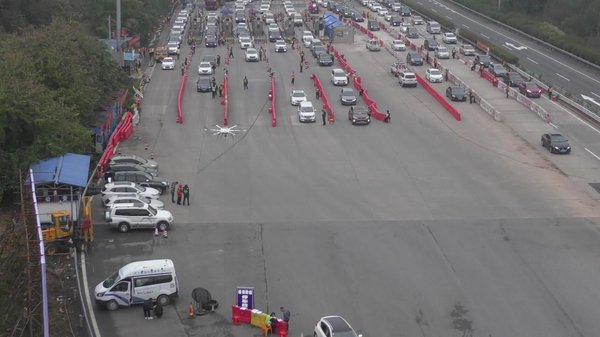Drone defence against COVID-19
Published 27-MAR-2020 12:54 P.M.
|
6 minute read
Hey! Looks like you have stumbled on the section of our website where we have archived articles from our old business model.
In 2019 the original founding team returned to run Next Investors, we changed our business model to only write about stocks we carefully research and are invested in for the long term.
The below articles were written under our previous business model. We have kept these articles online here for your reference.
Our new mission is to build a high performing ASX micro cap investment portfolio and share our research, analysis and investment strategy with our readers.
Click Here to View Latest Articles
In the COVID-19 era, technological innovation is paramount to not only helping to find a cure, but also ensuring people meet government restrictions and keeping service industries alive.
Therefore, med-tech companies, scientists, innovators and entrepreneurs are collaborating in interesting ways to combat the virus ... and potentially change the way we live, work and play forever.
Take JD.com for instance.
JD’s autonomous delivery robot successfully delivered products to Wuhan Ninth Hospital, the designated hospital for the treatment of COVID-19 in Wuhan in a bid to eliminate cross infection.
“JD autonomous delivery robots can help reduce human-to-human contact making them an ideal solution for last-mile delivery solution in Wuhan during this unique time, protecting both our customers and our employees.” said Qi Kong, Head of Autonomous Driving at JD Logistics. “In addition to supporting coronavirus aid in Wuhan, our latest autonomous delivery solution is open for other partners to use to upgrade their technology capabilities.”

China has been quick to innovate.
Shenzhen-based start-up Pudu Technology aims to reduce cross-infection by implementing home delivery of drugs and meals via robot. Food delivery service Ele.me is doing something similar by using robots to deliver meals to quarantined individuals suspected of having the virus. Delivery app Meituan Dianping, has also ramped up its ‘contactless delivery’ options through autonomous vehicles and robots.
The list of Chinese companies into robot innovation goes on, but one Australian university is also getting in on the act with a drone solution.
The rise of the COVID drone
The University of South Australia (UniSA) in partnership with Canadian drone-tech company Draganfly Inc. is developing a ‘pandemic drone’ to remotely monitor and detect people with infectious respiratory conditions.
The drone will be fitted with a specialised sensor and computer vision system that can monitor temperature, heart and respiratory rates, as well as detect people sneezing and coughing in crowds, offices, airports, cruise ships, aged care homes and other places where groups of people may work or congregate.
Led by Defence Chair of Sensor Systems Professor Javaan Chahl, the partners will work together to immediately integrate commercial, medical and government customers.
Professor Chahl has form in medical monitoring.
He worked alongside Dr Ali Al-Naji and Asanka Perera, to demonstrate image-processing algorithms that could extract a human’s heart rate from drone video.
The team achieved global recognition in 2017 and since then, has demonstrated that heart rate and breathing rate can be measured with high accuracy within 5-10 metres of people, using drones and at distances of up to 50 metres with fixed cameras. They have also developed algorithms that can interpret human actions such as sneezing and coughing.
Professor Chahl says the technology could be a viable screening tool for the COVID-19 pandemic.
“It might not detect all cases, but it could be a reliable tool to detect the presence of the disease in a place or in a group of people.”
The technology was originally envisaged for war zones and natural disasters as well as remotely monitoring heart rates of premature babies in incubators.
“Now, shockingly, we see a need for its use immediately, to help save lives in the biggest health catastrophe the world has experienced in the past 100 years.”
Draganfly will use its sensor, software and engineering expertise to work with UniSA to integrate and deploy for government, medical and commercial customers.
“We are honoured to work on such an important project given the current pandemic facing the world with Covid-19. Health and respiratory monitoring will be vital not only for detection but also to understand health trends,” Draganfly CEO Cameron Chell said.
Drones are being utilised more as companies come to terms with the current situation. Many are creating drone solutions that could have a positive impact on future health initiatives as well as providing support to healthcare now.
Other drone intitiatives
Here’s a list of companies using drones and the impact they have on the broader community.
Manchester University’s snood
Biochemists at Manchester University have developed a snood with “germ trap” technology.
This is actually 10-years in the making, with the university working closely with biotech firm Virustatic.
The fabric coating of the snood has a similar formation to the carbohydrate structures on the surfaces of the cells that cover the oesophagus.
Tests show the snood traps 96% of airborne viruses.
“The biggest spreader of viruses, the people you are treating, can’t wear existing masks,” said inventor Paul Hope. “If they could, that would reduce the virus within the hospital environment. Our snood mask moulds to your face, and it’s all the way round, not just your nose and mouth. It fits everyone.”
Virustatic intends to make as many as a million a week, with many to be used by England’s NHS.
MicroMultiCopter
Shenzhen’s MicroMultiCopter is designed to patrol areas and observe crowds and traffic more efficiently.

However, the drone can also detect people not wearing masks in public spaces and through thermal sensing help officials identify people with elevated body temperatures.
These drone could be used to fight coronavirus by spraying disinfectant in public spaces and be used to broadcast information to large areas.
Kuang-Chi Technologies smart helmet
Kuang-Chi Technologies has developed a smart helmet that can detect people with a fever up to five metres away.
The headset sounds an alarm when anyone with a high temperature comes close and is already used by police in Shenzhen, Chengdu and Shanghai. It can also beam data to the nearest hospital if required. The helmet is equipped with facial recognition technology and can display the subject’s name on the AR visor, as well as their medical history.
Terra Drone
Terra Drone has been able to curtail infection after obtaining the first urban drone delivery license issued by the Civil Aviation Administration of China.
The Japanese company’s drone has safely transported medical and other supplies from Xinchang County’s disease control center to the Xinchang County People’s Hospital.
3D-printed ventilator valves
When a hospital in Chiari, in the Brescia area of northern Italy, ran out of ventilators, Isinnova was there to help.
The Italian company made its first prototype 3D ventilator valve within six hours, and had 100 working valves supplied to the hospital within a day.
The hospital was dealing with 250 coronavirus patients in intensive care. The venturi valves connect the ventilator to a patient’s face mask, and need to be replaced for each patient.
Hence the requirement was critical.
Isinnova CEO Cristian Fracassi told the BBC : “The valve has very thin holes and tubes, smaller than 0.8m – it’s not easy to print the pieces ... Plus you have to respect not [contaminating] the product – really it should be produced in a clinical way.”
Since then, Isinnova has developed a 3D-printed adapter to turn a snorkelling mask into a non-invasive ventilator for coronavirus patients, to help to address the possible shortage of oxygen masks.
General Information Only
S3 Consortium Pty Ltd (S3, ‘we’, ‘us’, ‘our’) (CAR No. 433913) is a corporate authorised representative of LeMessurier Securities Pty Ltd (AFSL No. 296877). The information contained in this article is general information and is for informational purposes only. Any advice is general advice only. Any advice contained in this article does not constitute personal advice and S3 has not taken into consideration your personal objectives, financial situation or needs. Please seek your own independent professional advice before making any financial investment decision. Those persons acting upon information contained in this article do so entirely at their own risk.
Conflicts of Interest Notice
S3 and its associated entities may hold investments in companies featured in its articles, including through being paid in the securities of the companies we provide commentary on. We disclose the securities held in relation to a particular company that we provide commentary on. Refer to our Disclosure Policy for information on our self-imposed trading blackouts, hold conditions and de-risking (sell conditions) which seek to mitigate against any potential conflicts of interest.
Publication Notice and Disclaimer
The information contained in this article is current as at the publication date. At the time of publishing, the information contained in this article is based on sources which are available in the public domain that we consider to be reliable, and our own analysis of those sources. The views of the author may not reflect the views of the AFSL holder. Any decision by you to purchase securities in the companies featured in this article should be done so after you have sought your own independent professional advice regarding this information and made your own inquiries as to the validity of any information in this article.
Any forward-looking statements contained in this article are not guarantees or predictions of future performance, and involve known and unknown risks, uncertainties and other factors, many of which are beyond our control, and which may cause actual results or performance of companies featured to differ materially from those expressed in the statements contained in this article. S3 cannot and does not give any assurance that the results or performance expressed or implied by any forward-looking statements contained in this article will actually occur and readers are cautioned not to put undue reliance on forward-looking statements.
This article may include references to our past investing performance. Past performance is not a reliable indicator of our future investing performance.

